CPW Fed Compact UWB 4-Element MIMO Antenna with High Isolation
Abstract
:1. Introduction
2. Antenna Design and Structure
2.1. CPW Feed
2.2. Antenna Configuration
2.2.1. Single Element
2.2.2. MIMO Antenna
3. Influence of Special Structure
3.1. Semi Surround Ground Structure
3.2. Length of Radiating Patch
3.3. A Stub Connected to Feedline
4. Results and Discussions
4.1. S-Parameters
4.2. Surface Current Distribution
4.3. Radiation Patterns and Gain
4.4. MIMO Performance
4.5. Performance Comparison
5. Conclusions
Author Contributions
Funding
Institutional Review Board Statement
Informed Consent Statement
Data Availability Statement
Acknowledgments
Conflicts of Interest
References
- Federal Communications Commission. Federal Communications Commission Revision of Part 15 of the Commission’s Rules Regarding Ultra-Wideband Transmission System from 3.1 to 10.6 GHz, ET-Docket; Federal Communications Commission: Washington, DC, USA, 2002; pp. 98–153.
- Oppermann, I.; Hamalainen, M.; Iinatti, J. UWB Theory and Applications; Wiley: Chichester, UK, 2004; pp. 3–4. [Google Scholar]
- Zheng, L.; Tse, D.N.C. Diversity and multiplexing: A fundamental trade off in multiple-antenna channels. IEEE Trans. Inf. Theory 2003, 49, 1073–1096. [Google Scholar] [CrossRef] [Green Version]
- Balanis, C.A. Antenna Theory: Analysis and Design, 3rd ed.; Wiley: Hoboken, NJ, USA, 2005. [Google Scholar]
- Liu, L.; Cheung, S.W.; Yuk, T.I. Compact MIMO Antenna for portable devices in UWB applications. IEEE Trans. Antennas Propag. 2013, 61, 4257–4264. [Google Scholar] [CrossRef] [Green Version]
- Zhu, J.; Li, S.; Feng, B.; Deng, L.; Yin, S. Compact dual-polarized UWB quasi-self-complementary MIMO/diversity antenna with band-rejection capability. IEEE Antennas Wirel. Propag. Lett. 2016, 15, 905–908. [Google Scholar] [CrossRef]
- Khan, M.S.; Braaten, B.D.; Iftikhar, A.; Capobianco, A.D.; Ijaz, B.; Asif, S. Compact 4×4 UWB-MIMO antenna with WLAN band rejected operation. Electron. Lett. 2015, 51, 1048–1050. [Google Scholar] [CrossRef]
- Anitha, R.; Sarin, V.P.; Mohanan, P.; Vasudevan, K. Enhanced isolation with defected ground structure in MIMO antenna. Electron. Lett. 2014, 50, 1784–1786. [Google Scholar] [CrossRef]
- Deng, J.-Y.; Guo, L.-X.; Liu, X.-L. An ultrawideband MIMO Antenna with a high isolation. IEEE Antennas Wirel. Propag. Lett. 2016, 15, 182–185. [Google Scholar] [CrossRef]
- Chandel, R.; Gautam, A.K. Compact MIMO/diversity slot antenna for UWB applications with band-notched characteristic. Electron. Lett. 2016, 52, 336–338. [Google Scholar] [CrossRef]
- Chandel, R.; Gautam, A.K.; Rambabu, K. Tapered fed compact UWB MIMO-diversity antenna with dual band-notched characteristics. IEEE Trans. Antennas Propag. 2018, 66, 1677–1684. [Google Scholar] [CrossRef]
- Iqbal, A.; Saraereh, O.A.; Ahmad, A.W.; Bashir, S. Mutual coupling reduction using F-Shaped stubs in UWB-MIMO antenna. IEEE Access 2018, 6, 2755–2759. [Google Scholar] [CrossRef]
- Li, Q.; Feresidis, A.P.; Mavridou, M.; Hall, P.S. Miniaturized double-layer EBG structures for broadband mutual coupling reduction between UWB monopoles. IEEE Trans. Antennas Propag. 2015, 63, 1168–1171. [Google Scholar] [CrossRef]
- Zhang, S.; Pedersen, G.F. Mutual coupling reduction for UWB MIMO antennas with a wideband neutralization line. IEEE Antennas Wirel. Propag. Lett. 2016, 15, 166–169. [Google Scholar] [CrossRef]
- Srivastava, G.; Mohan, A. Compact MIMO slot antenna for UWB applications. IEEE Antennas Wirel. Propag. Lett. 2016, 15, 1057–1060. [Google Scholar] [CrossRef]
- Sipal, D.; Abegaonkar, M.P.; Koul, S.K. Easily extendable compact planar UWB MIMO antenna array. IEEE Antennas Wirel. Propag. Lett. 2017, 16, 2328–2331. [Google Scholar] [CrossRef]
- Yu, C.; Yang, S.; Chen, Y.; Wang, W.; Zhang, L.; Li, B.; Wang, L. A super-wideband and high isolation MIMO antenna system using a windmill-shaped decoupling structure. IEEE Access 2020, 8, 115767–115777. [Google Scholar] [CrossRef]
- Rekha, V.S.D.; Pardhasaradhi, P.; Madhav, B.T.P.; Devi, Y.U. Dual band notched orthogonal 4-element MIMO Antenna with isolation for UWB applications. IEEE Access 2020, 8, 145871–145880. [Google Scholar] [CrossRef]
- Thomas, K.G.; Sreenivasan, M. A simple ultrawideband planar rectangular printed Antenna with band dispensation. IEEE Trans. Antennas Propag. 2010, 58, 27–34. [Google Scholar] [CrossRef]
- Khan, M.S.; Capobianco, A.; Najam, A.I.; Shoaib, I.; Autizi, E.; Shafique, M.F. Compact ultra-wideband diversity antenna with a floating parasitic digitated decoupling structure. Microw. Antennas Propag. 2014, 8, 747–753. [Google Scholar] [CrossRef]
- Alsath, M.; Kanagasabai, M. Compact UWB monopole antenna for automotive communications. IEEE Trans. Antennas Propag. 2015, 63, 4204–4208. [Google Scholar] [CrossRef]
- Tian, R.; Lau, B.K.; Ying, Z. Multiplexing efficiency of MIMO antennas. IEEE Antennas Wirel. Propag. Lett. 2011, 10, 183–186. [Google Scholar] [CrossRef] [Green Version]



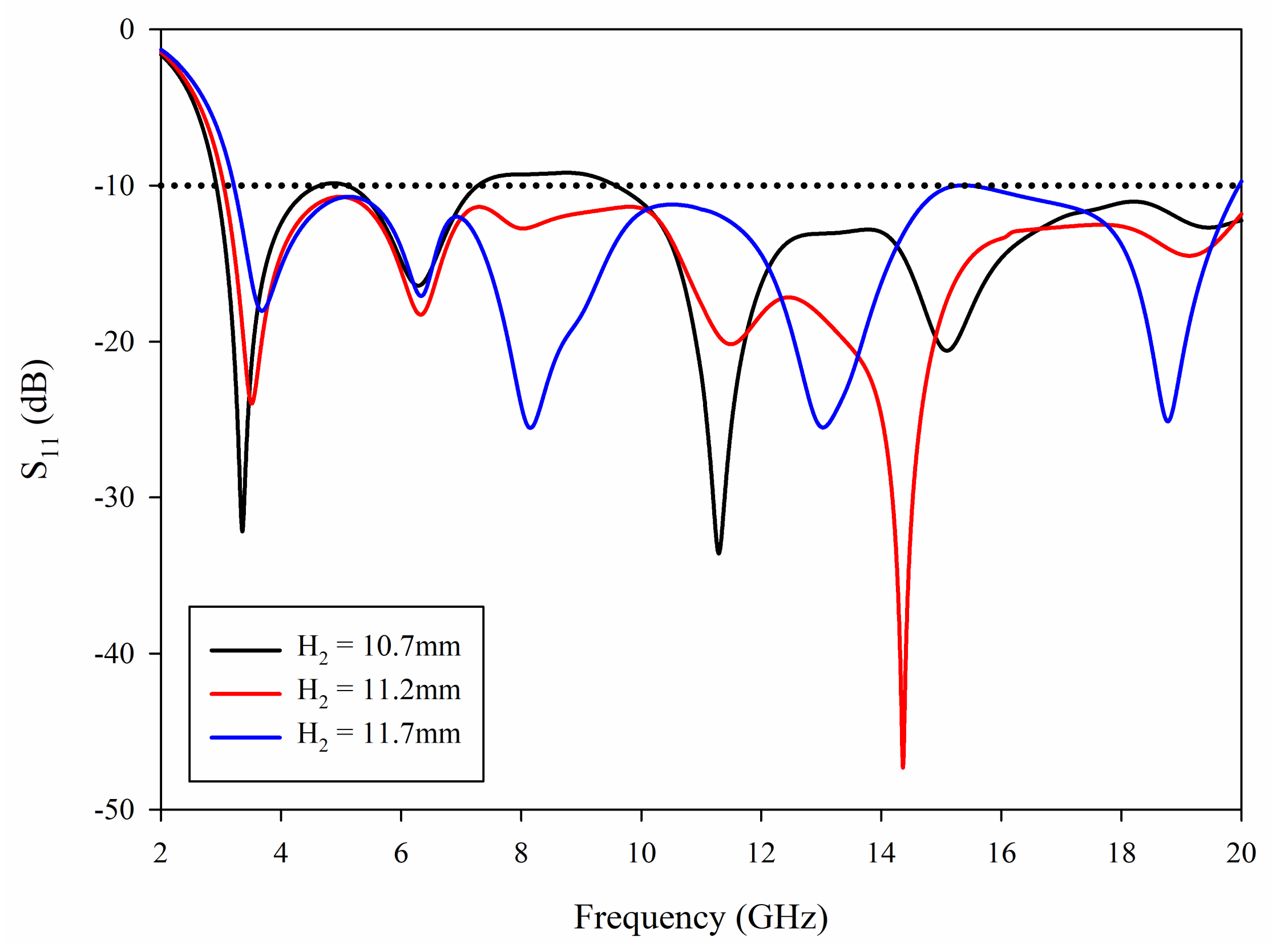

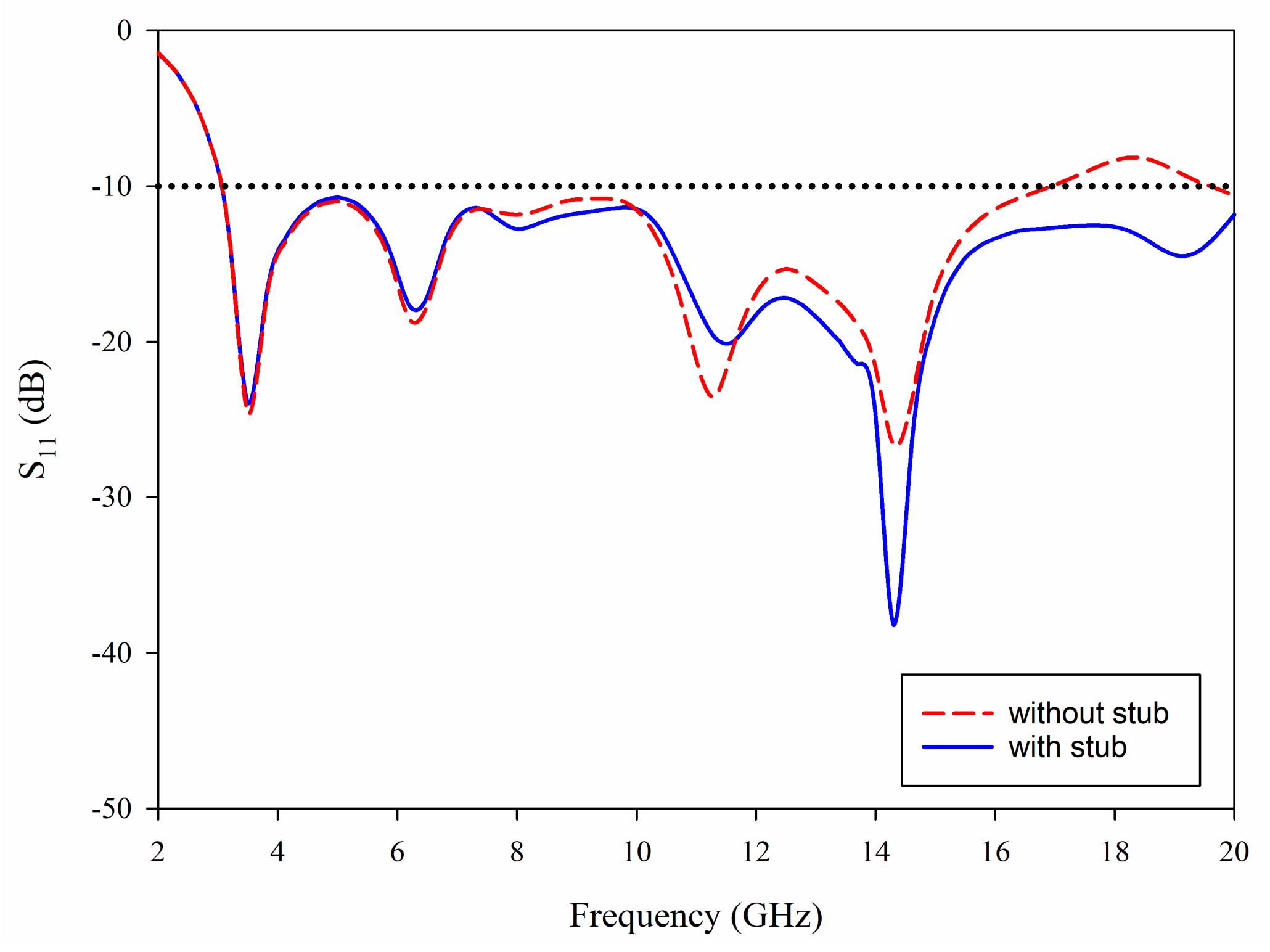
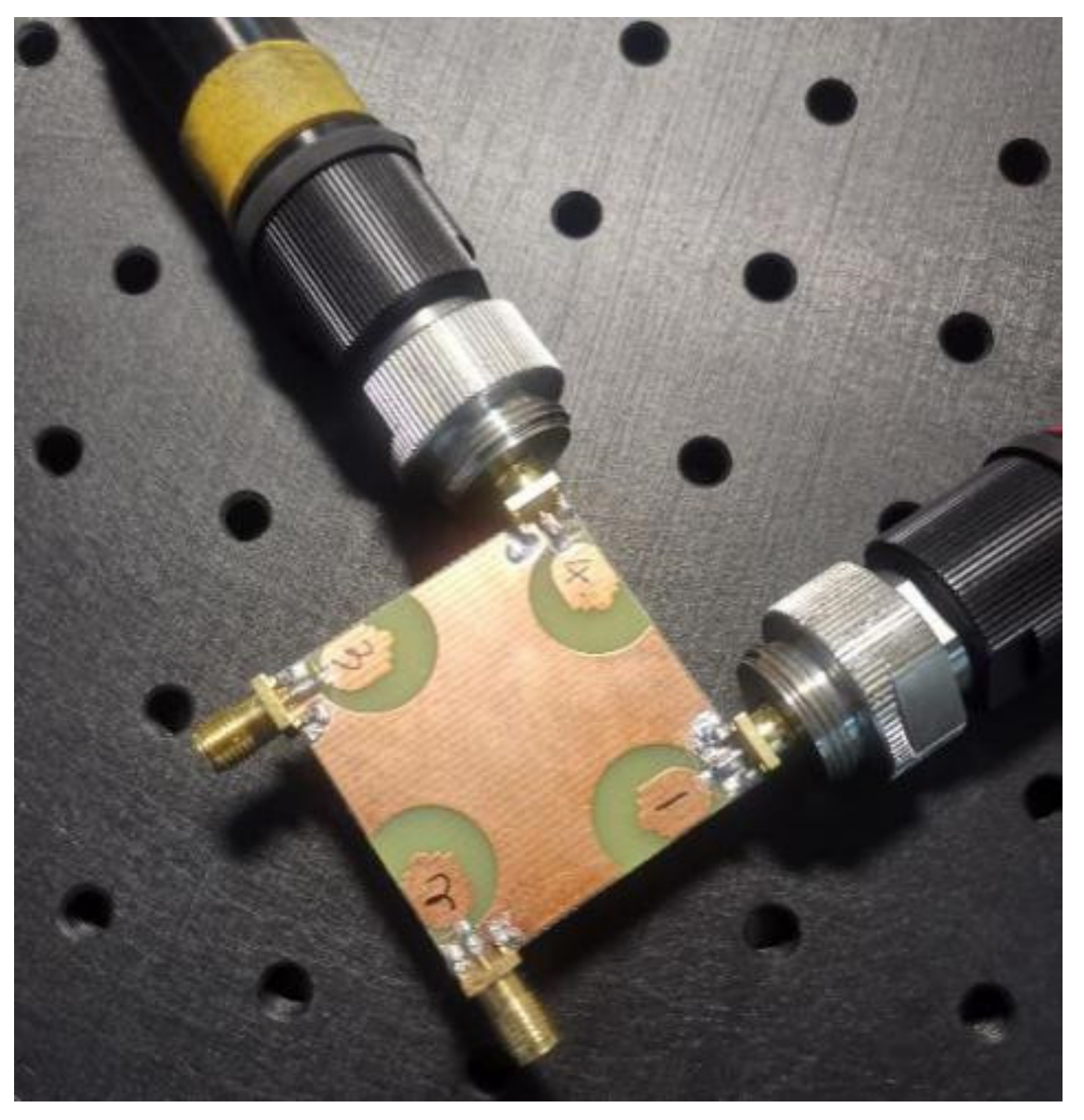
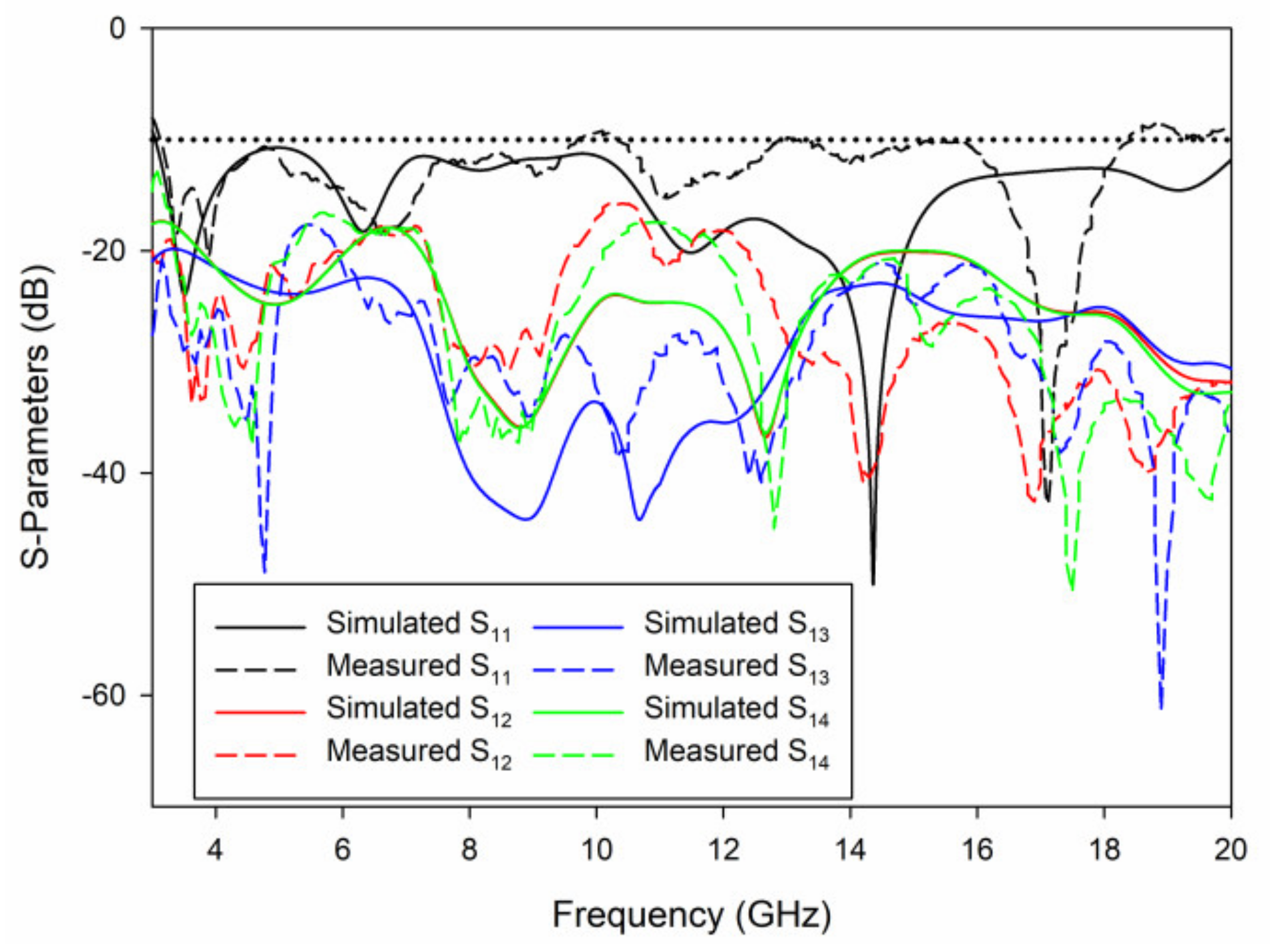


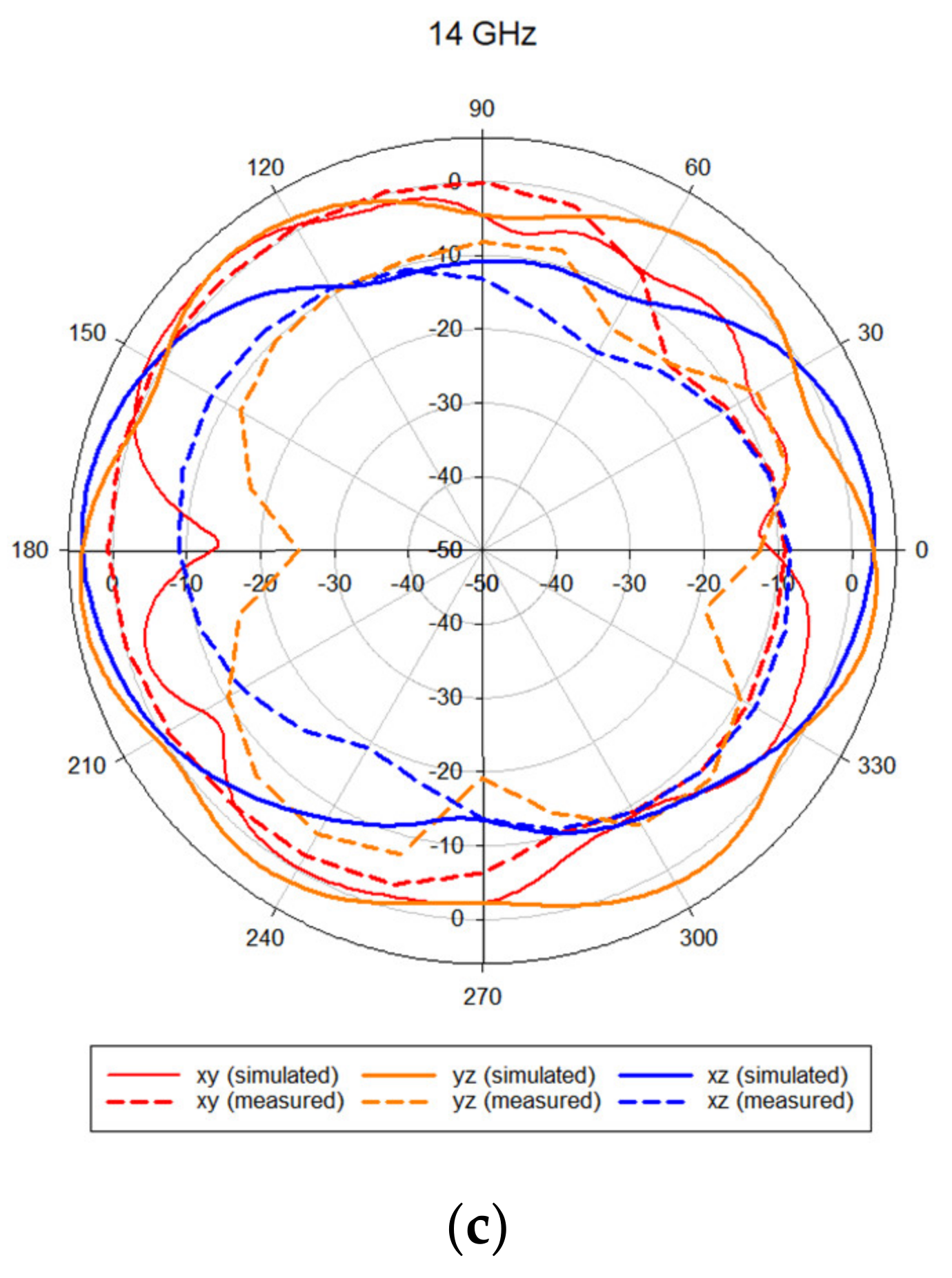
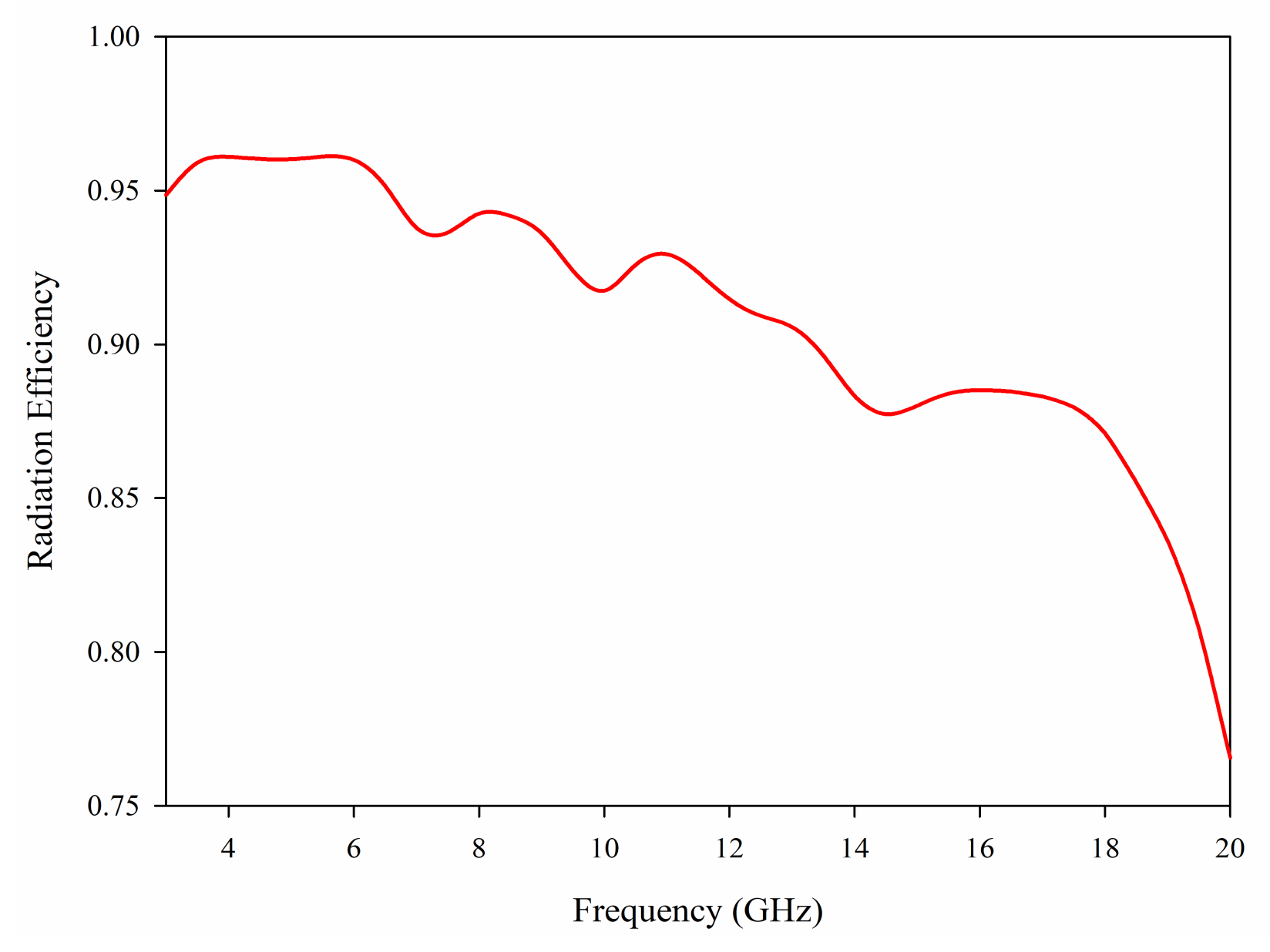
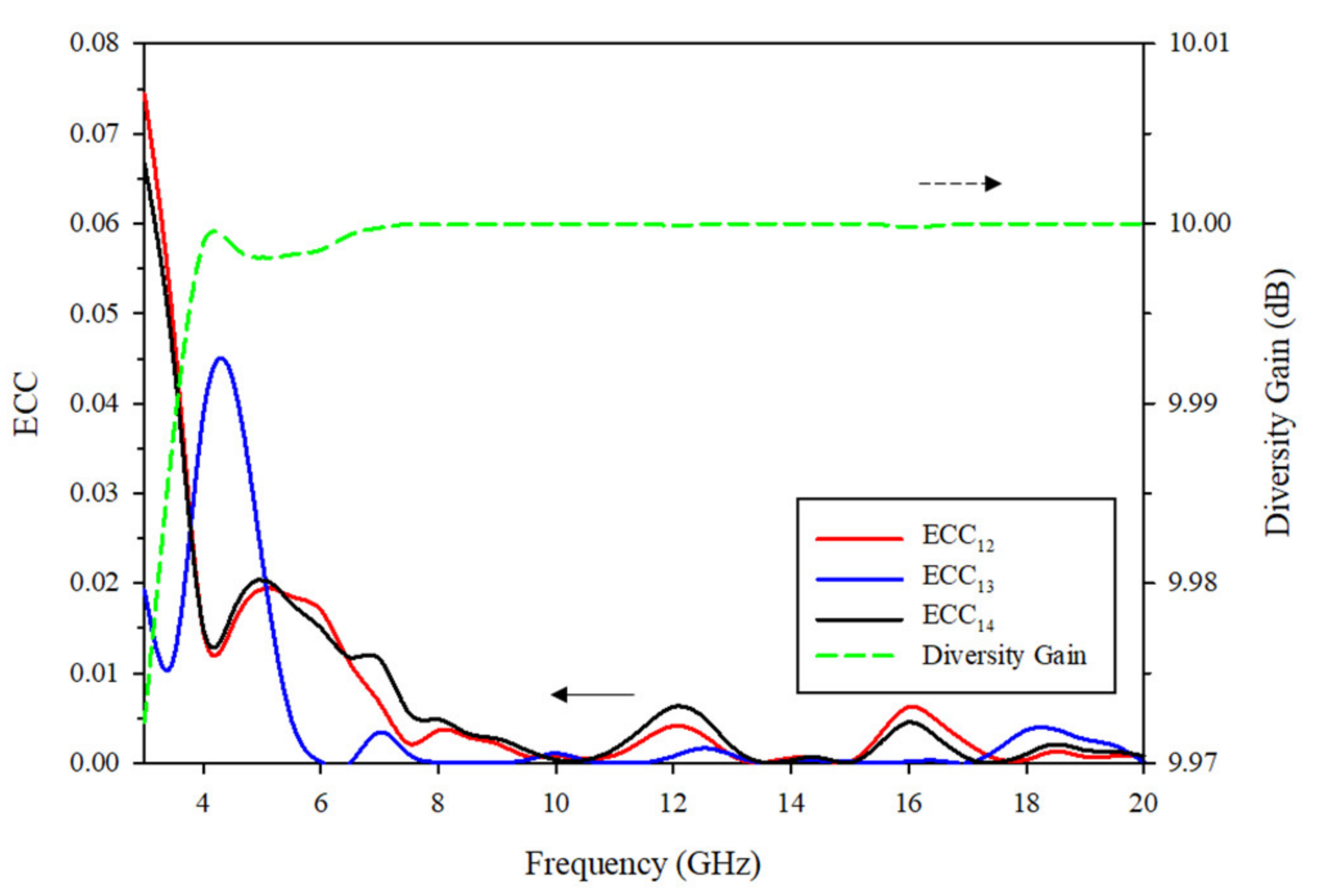

| W | Wf | W1 | W2 | W3 | W4 | H | H1 | H2 | H3 | g |
|---|---|---|---|---|---|---|---|---|---|---|
| 38 | 1.5 | 0.5 | 1 | 0.1 | 0.4 | 1.6 | 8.6 | 11.2 | 5 | 1.56 |
| L | Lp | L1 | L2 | L3 | L4 | R1 | R2 | R3 | l1 | l2 |
| 38 | 4 | 2 | 0.7 | 1.6 | 5.8 | 3.2 | 7.2 | 1.1 | 19 | 13.7 |
| Reference | Antenna Size (mm2) | Bandwidth (GHz) | Gain (dBi) | Isolation (dB) | ECC | Ports |
|---|---|---|---|---|---|---|
| [6] | 35 × 35 | 3.0–12 | NA | >20 | <0.3 | 2 |
| [9] | 30 × 40 | 3.1–10.6 | NA | >15 | <0.15 | 2 |
| [11] | 34 × 18 | 2.93–20 | 0–7 | >22 | <0.01 | 2 |
| [12] | 50 × 30 | 2.5–14.5 | 0.1–4 | >20 | <0.04 | 2 |
| [15] | 36 × 18 | 3.2–12 | 0–7 | >22 | <0.01 | 2 |
| [17] | 58 × 58 | 2.9–40 | 4.3–13.5 | >17 | <0.01 | 4 |
| [18] | 80 × 80 | 2.1–20 | 5.8 average | >25 | <0.02 | 4 |
| This work | 38 × 38 | 3.0–20 | 1.3–6.2 | >17 | <0.08 | 4 |
Publisher’s Note: MDPI stays neutral with regard to jurisdictional claims in published maps and institutional affiliations. |
© 2021 by the authors. Licensee MDPI, Basel, Switzerland. This article is an open access article distributed under the terms and conditions of the Creative Commons Attribution (CC BY) license (https://creativecommons.org/licenses/by/4.0/).
Share and Cite
Yin, W.; Chen, S.; Chang, J.; Li, C.; Khamas, S.K. CPW Fed Compact UWB 4-Element MIMO Antenna with High Isolation. Sensors 2021, 21, 2688. https://doi.org/10.3390/s21082688
Yin W, Chen S, Chang J, Li C, Khamas SK. CPW Fed Compact UWB 4-Element MIMO Antenna with High Isolation. Sensors. 2021; 21(8):2688. https://doi.org/10.3390/s21082688
Chicago/Turabian StyleYin, Wenfei, Shaoxiang Chen, Junjie Chang, Chunhua Li, and Salam K. Khamas. 2021. "CPW Fed Compact UWB 4-Element MIMO Antenna with High Isolation" Sensors 21, no. 8: 2688. https://doi.org/10.3390/s21082688
APA StyleYin, W., Chen, S., Chang, J., Li, C., & Khamas, S. K. (2021). CPW Fed Compact UWB 4-Element MIMO Antenna with High Isolation. Sensors, 21(8), 2688. https://doi.org/10.3390/s21082688







